Capacity of Multi-antenna Gaussian Channels
_I. Emre Telatar�
Abstract
We investigate the use of multiple transmitting and�or receiving antennas
for single user communications over the additive Gaussian channel with and
without fading. We derive formulas for the capacities and error exponents of
such channels, and describe computational procedures to evaluate such for-
mulas. We show that the potential gains of such multi-antenna systems over
single-antenna systems is rather large under independence assumptions for the
fades and noises at di�erent receiving antennas.
�
Introduction
We will consider a single user Gaussian channel with multiple transmitting and�or
receiving antennas. We will denote the number of transmitting antennas by t and the
number of receiving antennas by r. We will exclusively deal with a linear model in
which the received vector y � C r depends on the transmitted vector x � C t via
y = Hx + n
���
where H is a r � t complex matrix and n is zero-mean complex Gaussian noise with
independent, equal variance real and imaginary parts. We assume E�nny� = Ir, that
is, the noises corrupting the di�erent receivers are independent. The transmitter is
constrained in its total power to P ,
Equivalently, since xyx = tr�xxy�, and expectation and trace commute,
E�xyx� � P:
tr�E�xxy�� � P:
���
�Rm. �C-���, Lucent Technologies, Bell Laboratories, ��� Mountain Avenue, Murray Hill, NJ,
USA �� ��, telatar@lucent.com
�
�
This second form of the power constraint will prove more useful in the upcoming
discussion.
We will consider several scenarios for the matrix H:
�. H is deterministic.
�. H is a random matrix �for which we shall use the notation H�, chosen according
to a probability distribution, and each use of the channel corresponds to an
independent realization of H.
�. H is a random matrix, but is �xed once it is chosen.
The main focus of this paper in on the last two of these cases. The �rst case is
included so as to expose the techniques used in the later cases in a more familiar
context.
In the cases when H is random, we will assume that its entries form an
i.i.d. Gaussian collection with zero-mean, independent real and imaginary parts, each
with variance �=�. Equivalently, each entry of H has uniform phase and Rayleigh
magnitude. This choice models a Rayleigh fading environment with enough separation
within the receiving antennas and the transmitting antennas such that the fades for
each transmitting-receiving antenna pair are independent. In all cases, we will assume
that the realization of H is known to the receiver, or, equivalently, the channel output
consists of the pair �y; H�, and the distribution of H is known at the transmitter.
� Preliminaries
A complex random vector x � C n is said to be Gaussian if the real random vector
Im�x�i, is Gaussian. Thus,
^x � R�n consisting of its real and imaginary parts, ^x = hRe�x�
to specify the distribution of a complex Gaussian random vector x, it is necessary to
specify the expectation and covariance of ^x, namely,
E�^x� � R�n
and
E��^x E�^x���^x E�^x��y� � R�n��n:
We will say that a complex Gaussian random vector x is circularly symmetric if the
covariance of the corresponding ^x has the structure
E��^x E�^x���^x E�^x��y� =
�
��Re�Q� Im�Q�
Re�Q��
Im�Q�
���
for some Hermitian non-negative de�nite Q � C n�n. Note that the real part of an
Hermitian matrix is symmetric and the imaginary part of an Hermitian matrix is
anti-symmetric and thus the matrix appearing in ��� is real and symmetric. In this
case E��xE�x���xE�x��y� = Q, and thus, a circularly symmetric complex Gaussian
random vector x is speci�ed by prescribing E�x� and E��x E�x���x E�x��y�.
�
�
For any z � C n and A � C n�m de�ne
^z =�Re�z�
Im�z��
and
Lemma �. The mappings z ! ^z = hRe�z�
following properties:
Im�A�
^A =�Re�A� Im�A�
Re�A�� :
Im�z�i and A ! ^A = hRe�A� Im�A�
Im�A� Re�A�i have the
C = AB �� ^C = ^A ^B
C = A + B �� ^C = ^A + ^B
C = Ay �� ^C = ^Ay
C = A� �� ^C = ^A�
det� ^A� = j det�A�j� = det�AAy�
z = x + y �� ^z = ^x + ^y
y = Ax �� ^y = ^A^x
Re�xyy� = ^xy ^y:
��a�
��b�
��c�
��d�
��e�
��f�
��g�
��h�
Proof. The properties ��a�, ��b� and ��c� are immediate. ��d� follows from ��a� and
the fact that ^In = I�n. ��e� follows from
det� ^A� = det��I
�
iI
I� ^A�I iI
I�
= det�� A
Im�A� A��
= det�A� det�A��:
�
�
��f�, ��g� and ��h� are immediate.
Corollary �. U � C n�n is unitary if and only if ^U � R�n��n is orthonormal.
Proof. U yU = In �� � ^U �y ^U = ^In = I�n.
Corollary �. If Q � C n�n is non-negative de�nite then so is ^Q � R�n��n .
Proof. Given x = �x�; : : : ; x�n�y � R�n , let z = �x� + jxn+�; : : : ; xn + jx�n�y � C n, so
that x = ^z. Then by ��g� and ��h�
xy ^Qx = Re�zyQz� = zyQz � �:
The probability density �with respect to the standard Lebesgue measure on C n�
of a circularly symmetric complex Gaussian with mean � and covariance Q is given
�
�
by
��;Q�x� = det�� ^Q��=� exp�^x ^��y ^Q��^x ^���
= det��Q�� exp�x ��yQ��x ���
where the second equality follows from ��d����h�. The di�erential entropy of a com-
plex Gaussian x with covariance Q is given by
H��Q� = E �Q� log �Q�x��
= log det��Q� + �log e�E�xyQ�x�
= log det��Q� + �log e� tr�E�xxy�Q��
= log det��Q� + �log e� tr�I�
= log det��eQ�:
For us, the importance of the circularly symmetric complex Gaussians is due to the
following lemma: circularly symmetric complex Gaussians are entropy maximizers.
Lemma �. Suppose the complex random vector x � C n is zero-mean and satis�es
E�xxy� = Q, i.e., E�xix�
j � = Qij, � � i; j � n. Then the entropy of x satis�es
H�x� � log det��eQ� with equality if and only if x is a circularly symmetric complex
Gaussian with
E�xxy� = Q
j dx = Qij, � � i; j � n.
j dx = Qij, and that log �Q�x� is a linear combination of
Let
the terms xix�
Proof. Let p be any density function satisfying RC n p�x�xix�
�Q�x� = det��Q�� expxyQ�x�:
Observe that RC n �Q�x�xix�
j . Thus E �Q�log �Q�x�� = E p�log �Q�x��. Then,
H�p� H��Q� = ZC n
= ZC n
=ZC n
� �;
p�x� log p�x� dx +ZC n
p�x� log p�x� dx +ZC n
p�x� log
�Q�x�
p�x�
dx
�Q�x� log �Q�x� dx
p�x� log �Q�x� dx
with equality only if p = �Q. Thus H�p� � H��Q�.
Lemma �. If x � C n is a circularly symmetric complex Gaussian then so is y = Ax
for any A � C m�n.
�
�
Proof. We may assume x is zero-mean. Let Q = E�xxy�. Then y is zero-mean,
^y = ^A^x, and
E�^y ^yy� = ^AE�^x^xy� ^Ay = �
�
^A ^Q ^Ay = �
�
^K
where K = AQAy.
Lemma �. If x and y are independent circularly symmetric complex Gaussians, then
z = x + y is a circularly symmetric complex Gaussian.
Proof. Let A = E�xxy� and B = E�yyy�. Then E�^z ^zy� = �
^C with C = A + B.
�
� The Gaussian channel with fixed transfer function
We will start by reminding ourselves the case of deterministic H. The results of this
section can be inferred from ��, Ch. ��
�.� Capacity
We will �rst derive an expression for the capacity C�H; P � of this channel. To that
end, we will maximize the average mutual information I�x; y� between the input and
the output of the channel over the choice of the distribution of x.
By the singular value decomposition theorem, any matrix H � C r�t can be written
as
H = UDV y
where U � C r�r and V � C t�t are unitary, and D � Rr�t is non-negative and diagonal.
In fact, the diagonal entries of D are the non-negative square roots of the eigenvalues
of HH y, the columns of U are the eigenvectors of HH y and the columns of V are the
eigenvectors of H yH. Thus, we can write ��� as
y = UDV yx + n:
Let ~y = U yy, ~x = V yx, ~n = U yn. Note that U and V are invertible, ~n has the same
distribution as n and, E�~xy ~x� = E�xyx�. Thus, the original channel is equivalent to
the channel
~y = D ~x + ~n
���
where ~n is zero-mean, Gaussian, with independent, identically distributed real and
imaginary parts and E� ~n ~ny� = Ir. Since H is of rank at most minfr; tg, at most
minfr; tg of the singular values of it are non-zero. Denoting these by ��=�
, i =
�; : : : ; minfr; tg, we can write ��� component-wise, to get
i
~yi = ��=�
i ~xi + ~ni;
� � i � minfr; tg;
�
�
and the rest of the components of ~y �if any� are equal to the corresponding components
of ~n. We thus see that ~yi for i � minft; rg is independent of the transmitted signal and
that ~xi for i � minft; rg don’t play any role. To maximize the mutual information,
we need to choose f~xi : � � i � minfr; tgg to be independent, with each ~xi having
independent Gaussian, zero-mean real and imaginary parts. The variances need to
be chosen via �water-�lling" as
E�Re�~xi��� = E�Im�~xi��� = �
��� ��
i �+
where � is chosen to meet the power constraint. Here, a+ denotes maxf�; ag. The
power P and the maximal mutual information can thus be parametrized as
P ��� =Xi � ��
i �+;
C��� =Xi ln���i��+:
Remark � �Reciprocity�. Since the non-zero eigenvalues of H yH are the same as those
of HH y, we see that the capacities of channels corresponding to H and H y are the
same.
Example �. Take Hij = � for all i; j. We can write H as
p�=r
...p�=r
H =�
��
�
��prt�hp�=t : : :p�=ti
and we thus see that in the singular value decomposition of H the diagonal matrix
D will have only one non-zero entry, prt. �We also see that the �rst column of U is
p�=r��; : : : ; ��y and the �rst column of V is p�=t��; : : : ; ��y.� Thus,
C = log�� + rtP �:
The x = V ~x that achieves this capacity satis�es E�xix�
j � = P=t for all i; j, i.e., the
transmitters are all sending the same signal. Note that, even though each transmitter
is sending a power of P=t, since their signals add coherently at the receiver, the power
received at each receiver is P t. Since each receiver sees the same signal and the noises
at the receivers are uncorrelated the overall signal to noise ratio is P rt.
Example �. Take r = t = n and H = In. Then
C = n log�� + P=n�
For x that achieves this capacity E�xix�
j � = �ijP=n, i.e, the components of x are i.i.d.
However, it is incorrect to infer from this conclusion that to achieve capacity one has
to do independent coding for each transmitter. It is true that the capacity of this
�
�
channel can be achieved by splitting the incoming data stream into t streams, coding
and modulating these schemes separately, and then sending the t modulated signals
over the di�erent transmitters. But, suppose Nt bits are going to be transmitted,
and we will either separate them into t groups of N bits each and use each group to
select one of �N signals for each transmitter, or, we will use all all Nt bits to select
one of �N t signal vectors. The second of these alternatives will yield a probability of
error much smaller than the �rst, at the expense of much greater complexity. Indeed,
the log of the error probability in the two cases will di�er by a factor of t. �See the
error exponents of parallel channels in ��, pp. �� �����.�
�.� Alternative Derivation of the Capacity
The mutual information I�x; y� can be written as
I�x; y� = H�y� H�yjx� = H�y� H�n�;
and thus maximizing I�x; y� is equivalent to maximizing H�y�. Note that if x satis�es
E�xyx� � P , so does x E�x�, so we can restrict our attention to zero-mean x.
Furthermore, if x is zero-mean with covariance E�xxy� = Q, then y is zero-mean
with covariance E�yyy� = HQH y + Ir, and by Lemma � among such y the entropy
is largest when y is circularly symmetric complex Gaussian, which is the case when
x is circularly symmetric complex Gaussian �Lemmas � and ��. So, we can further
restrict our attention to circularly symmetric complex Gaussian x. In this case the
mutual information is given by
I�x; y� = log det�Ir + HQH y� = log det�It + QH yH�
where the second equality follows from the determinant identity det�I+AB� = det�I+
BA�, and it only remains to choose Q to maximize this quantity subject to the
constraints tr�Q� � P and that Q is non-negative de�nite. The quantity log det�I +
HQH y� will occur in this document frequently enough that we will let
�Q; H� = log det�I + HQH y�
to denote it. Since H yH is Hermitian it can be diagonalized, H yH = U y�U, with
unitary U and non-negative diagonal � = diag���; : : : ; �t�. Applying the determinant
identity again we see that
det�Ir + HQH y� = det�It + ��=�UQU y��=��:
Observe that ~Q = U QU y is non-negative de�nite when and only when Q is, and that
tr� ~Q� = tr�Q�; thus the maximization over Q can be carried equally well over ~Q.
�
�
Note also that for any non-negative de�nite matrix A, det�A� �Qi Aii, thus
det�Ir + ��=� ~Q��=�� �Yi
�� + ~Qii�i�
with equality when ~Q is diagonal. Thus we see that the maximizing ~Q is diagonal,
and the optimal diagonal entries can be found via �water-�lling" to be
~Qii =� ��
i �+;
i = �; : : : ; t
~Qii = P . The corresponding maximum mutual infor-
where � is chosen to satisfyPi
mation is given by
as before.
�.� Error Exponents
Xi log���i��+
Knowing the capacity of a channel is not always su�cient. One may be interested
in knowing how hard it is to get close to this capacity. Error exponents provide a
partial answer to this question by giving an upper bound to the probability of error
achievable by block codes of a given length n and rate R. The upper bound is known
as the random coding bound and is given by
P�error� � exp�nEr�R��;
where the random coding exponent Er�R� is given by
Er�R� = max
�����
E���� �R;
where, in turn, E���� is given by the supremum over all input distributions qx satis-
fying the energy constraint of
E���; qx� = logZ �Z qx�x�p�yjx��=��+�� dx��+�
dy:
In our case p�yjx� = det��Ir�� exp�yx�y�yx��. If we choose qx as the Gaussian
distribution �Q we get �after some algebra�
E���; Q� = � log det�Ir + �� + ���HQH y� = � �� + ����Q; H�:
�
�
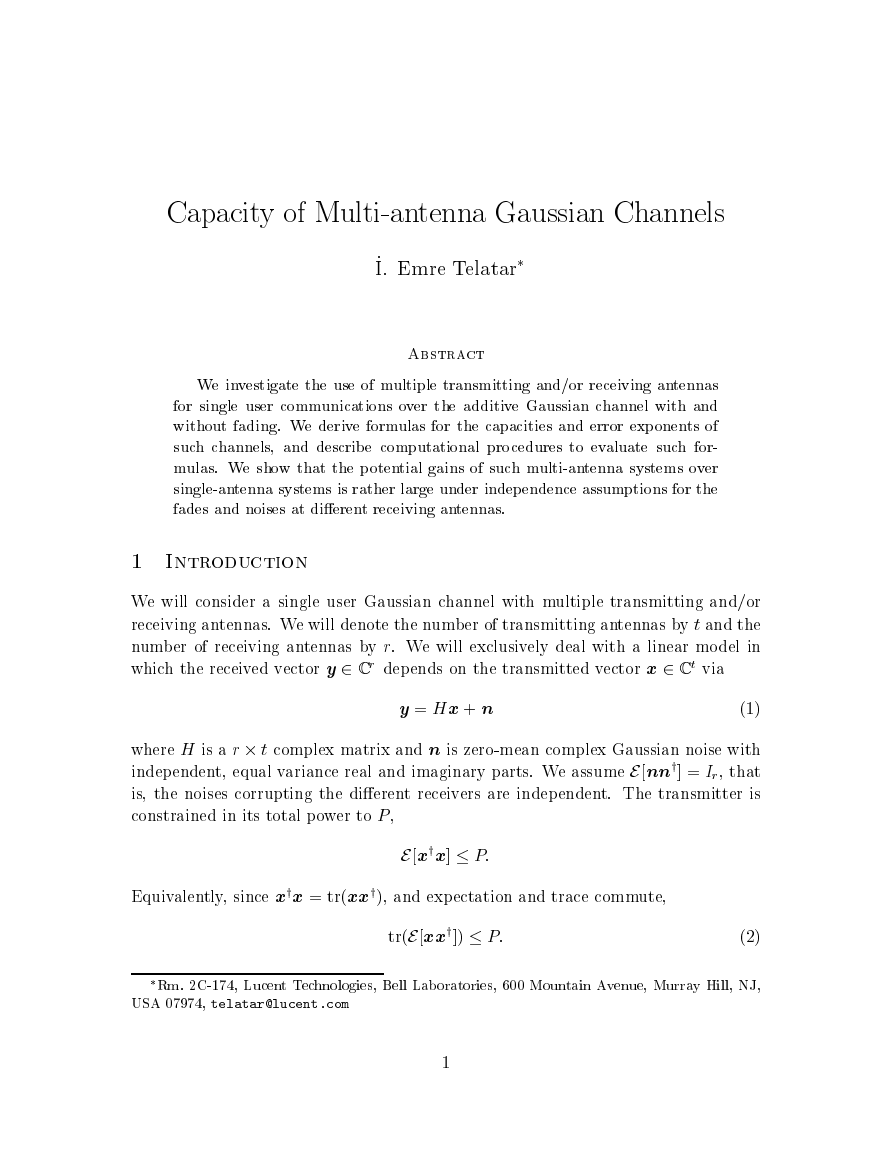
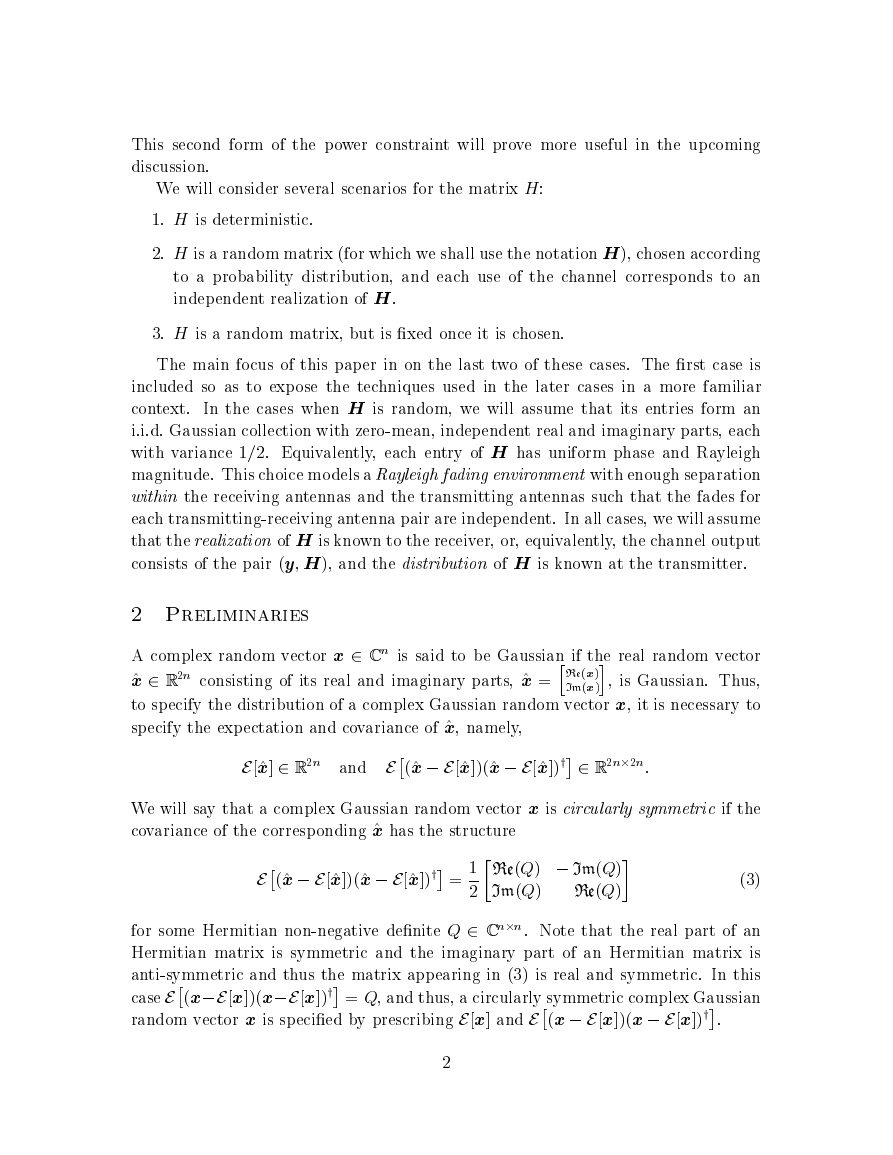
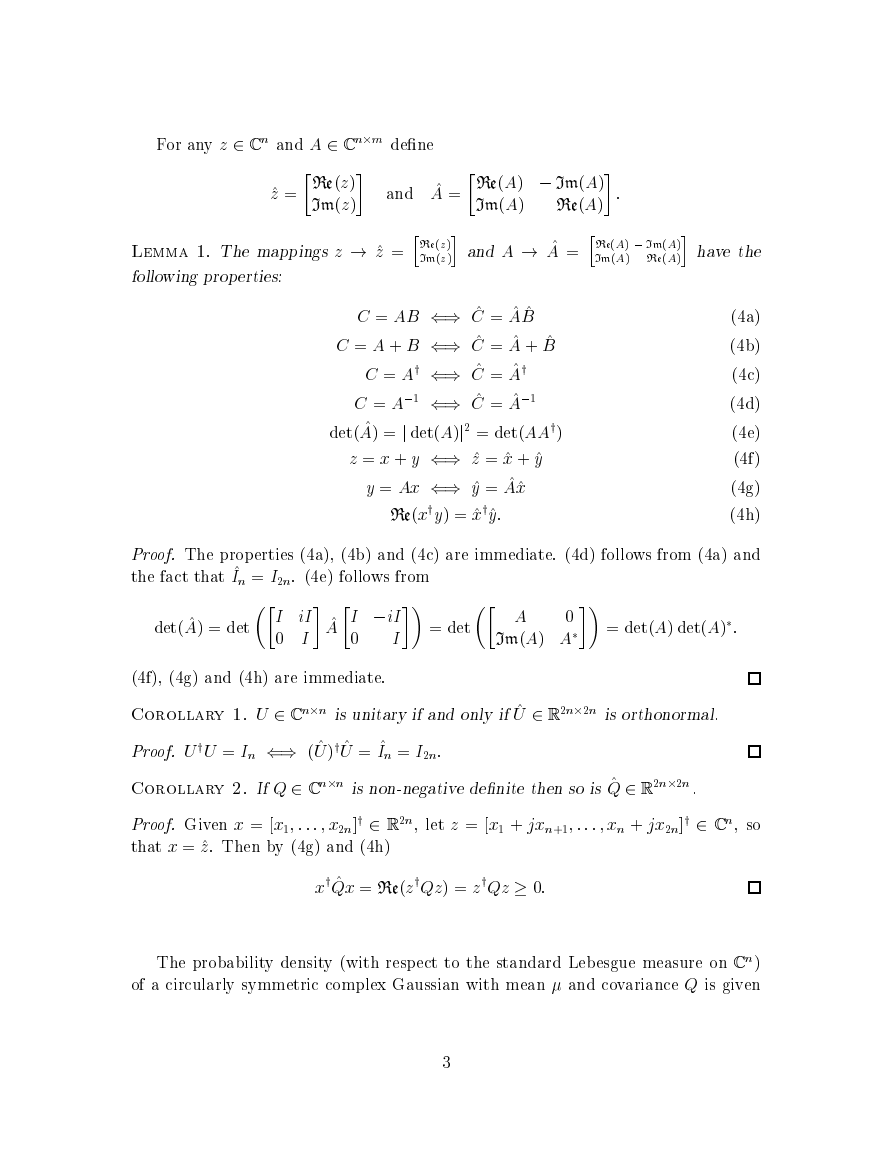
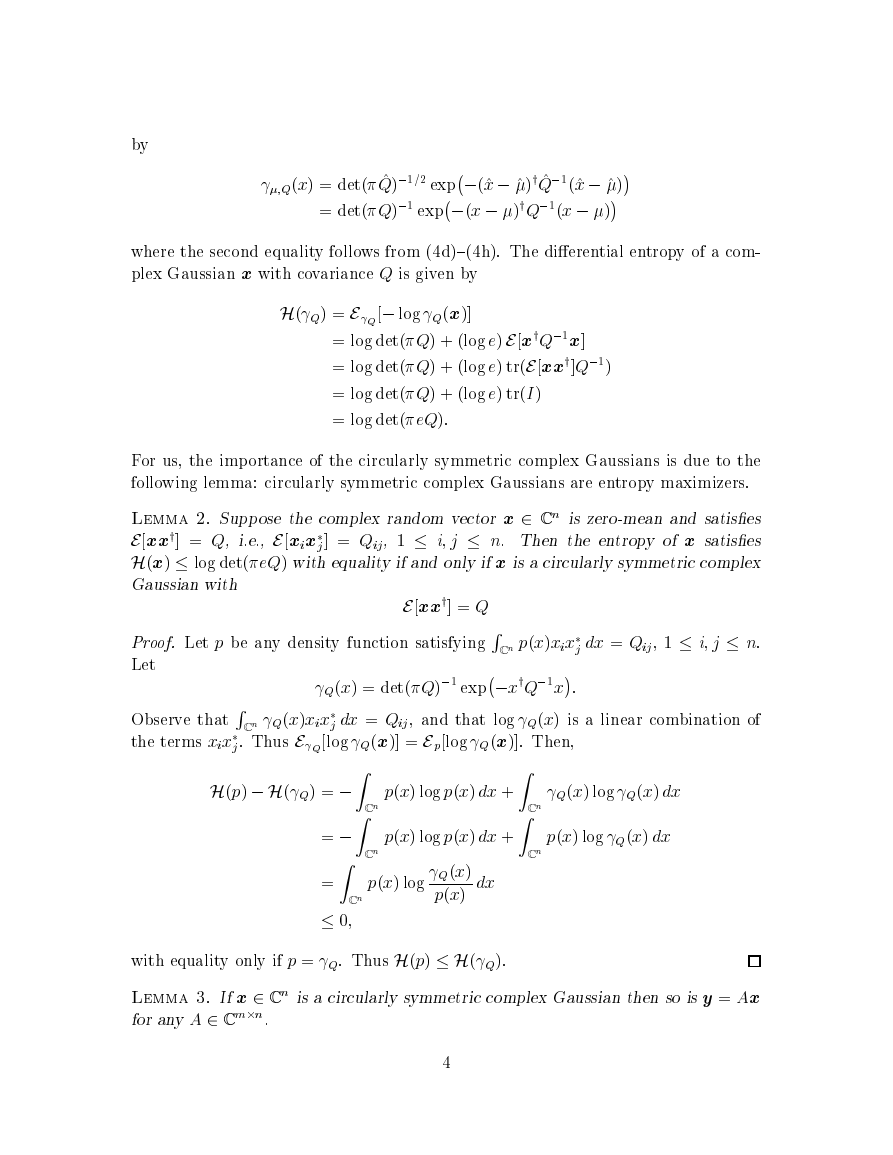
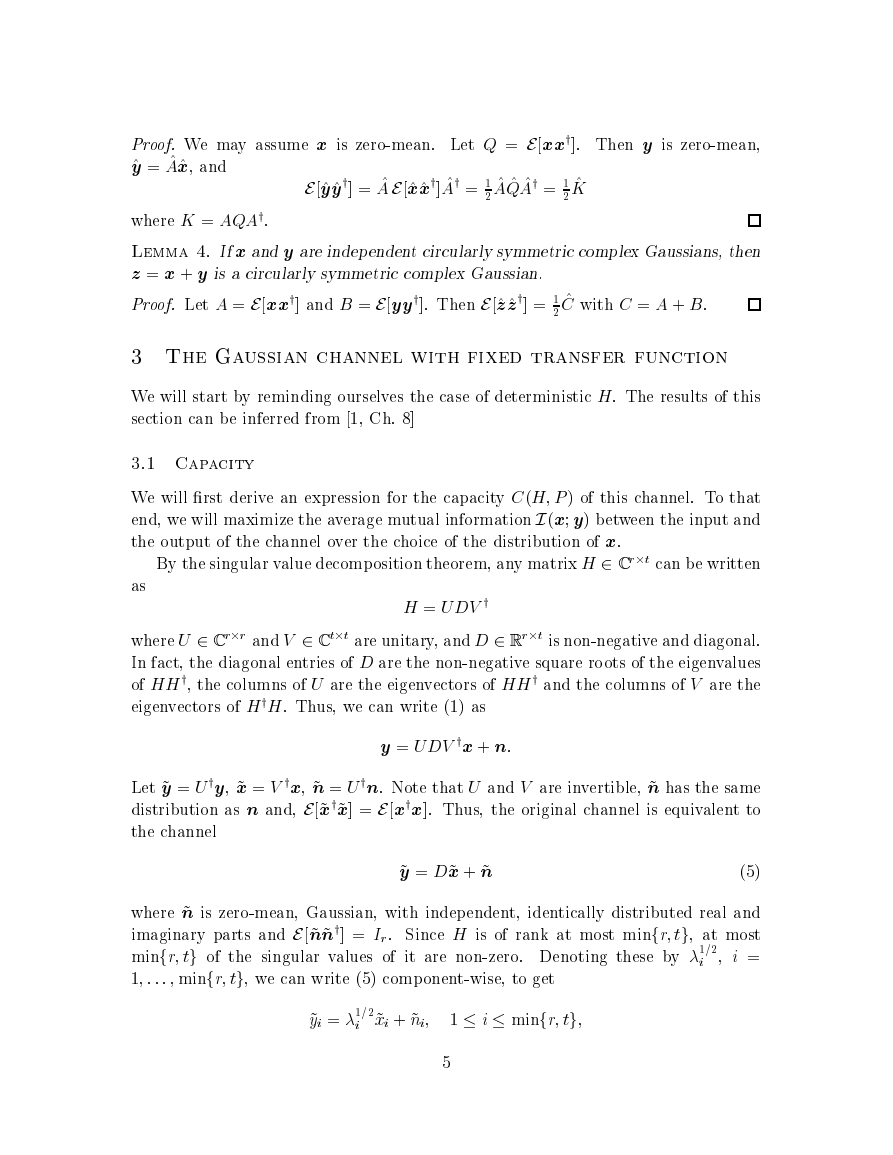
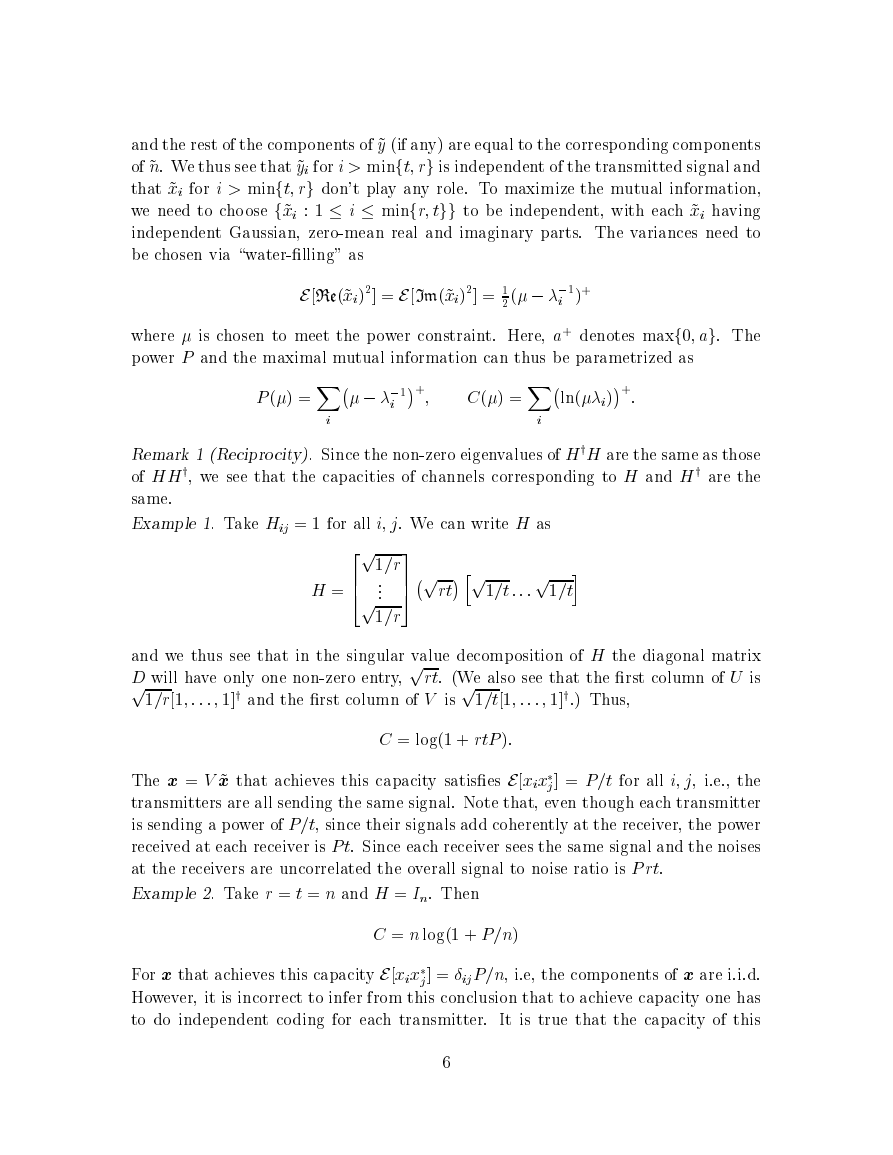
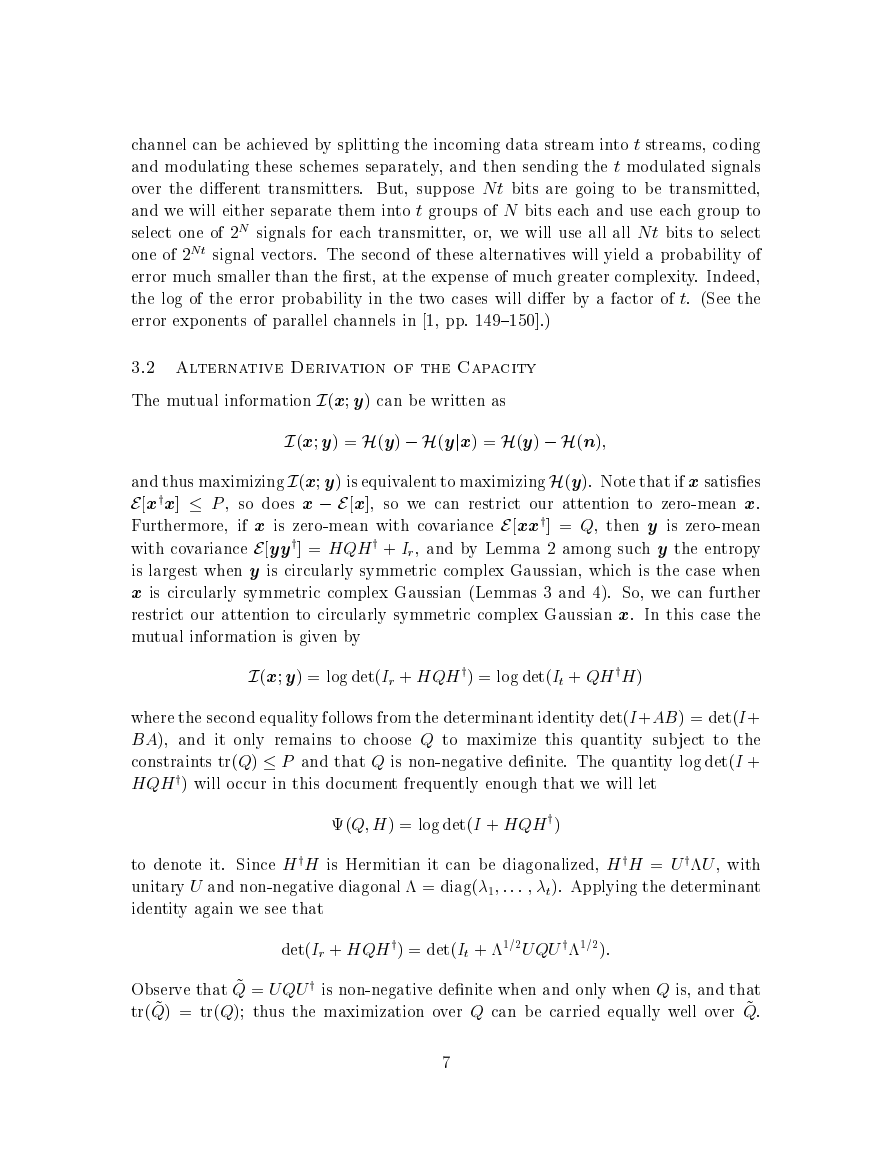
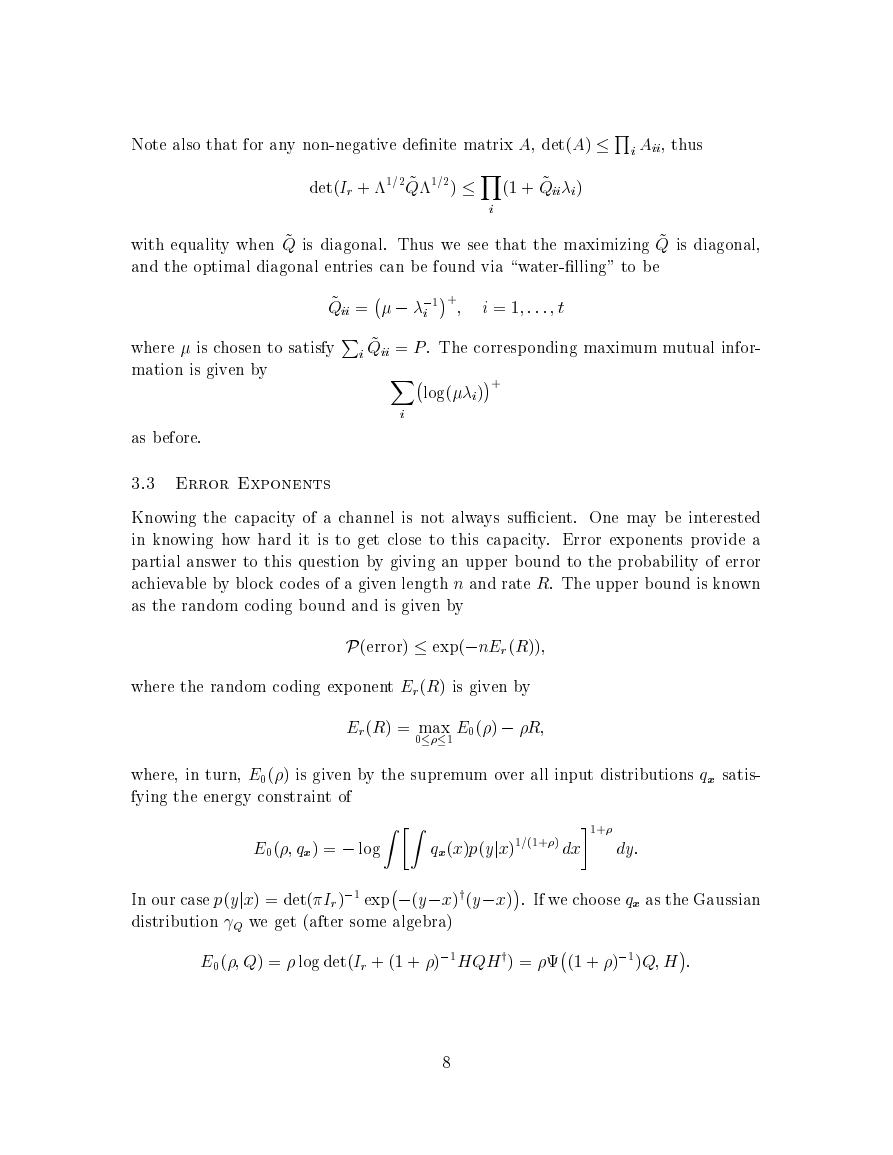








 2023年江西萍乡中考道德与法治真题及答案.doc
2023年江西萍乡中考道德与法治真题及答案.doc 2012年重庆南川中考生物真题及答案.doc
2012年重庆南川中考生物真题及答案.doc 2013年江西师范大学地理学综合及文艺理论基础考研真题.doc
2013年江西师范大学地理学综合及文艺理论基础考研真题.doc 2020年四川甘孜小升初语文真题及答案I卷.doc
2020年四川甘孜小升初语文真题及答案I卷.doc 2020年注册岩土工程师专业基础考试真题及答案.doc
2020年注册岩土工程师专业基础考试真题及答案.doc 2023-2024学年福建省厦门市九年级上学期数学月考试题及答案.doc
2023-2024学年福建省厦门市九年级上学期数学月考试题及答案.doc 2021-2022学年辽宁省沈阳市大东区九年级上学期语文期末试题及答案.doc
2021-2022学年辽宁省沈阳市大东区九年级上学期语文期末试题及答案.doc 2022-2023学年北京东城区初三第一学期物理期末试卷及答案.doc
2022-2023学年北京东城区初三第一学期物理期末试卷及答案.doc 2018上半年江西教师资格初中地理学科知识与教学能力真题及答案.doc
2018上半年江西教师资格初中地理学科知识与教学能力真题及答案.doc 2012年河北国家公务员申论考试真题及答案-省级.doc
2012年河北国家公务员申论考试真题及答案-省级.doc 2020-2021学年江苏省扬州市江都区邵樊片九年级上学期数学第一次质量检测试题及答案.doc
2020-2021学年江苏省扬州市江都区邵樊片九年级上学期数学第一次质量检测试题及答案.doc 2022下半年黑龙江教师资格证中学综合素质真题及答案.doc
2022下半年黑龙江教师资格证中学综合素质真题及答案.doc